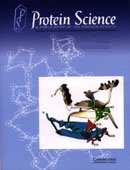Crossref Citations
This article has been cited by the following publications. This list is generated based on data provided by
Crossref.
Zwickl, Peter
Seemüller, Erika
Kapelari, Barbara
and
Baumeister, Wolfgang
2001.
Protein Folding in the Cell.
Vol. 59,
Issue. ,
p.
187.
Zwickl, P.
2002.
The Proteasome — Ubiquitin Protein Degradation Pathway.
Vol. 268,
Issue. ,
p.
23.
Witt, Susanne
Baumeister, Wolfgang
Fahnestock, Stephen R.
and
Steinbüchel, Alexander
2002.
Biopolymers Online.
Unno, Masaki
Mizushima, Tsunehiro
Morimoto, Yukio
Tomisugi, Yoshikazu
Tanaka, Keiji
Yasuoka, Noritake
and
Tsukihara, Tomitake
2002.
The Structure of the Mammalian 20S Proteasome at 2.75 Å Resolution.
Structure,
Vol. 10,
Issue. 5,
p.
609.
Dieterich, Daniela C.
Landwehr, Marco
Reissner, Carsten
Smalla, Karl‐Heinz
Richter, Karin
Wolf, Gerald
Böckers, Tobias M.
Gundelfinger, Eckart D.
and
Kreutz, Michael R.
2003.
Gliap − a novel untypical l‐asparaginase localized to rat brain astrocytes.
Journal of Neurochemistry,
Vol. 85,
Issue. 5,
p.
1117.
Pei, Jimin
and
Grishin, Nick V.
2003.
Peptidase family U34 belongs to the superfamily of N‐terminal nucleophile hydrolases.
Protein Science,
Vol. 12,
Issue. 5,
p.
1131.
Alkema, Wynand B. L.
de Vries, Erik
Floris, René
and
Janssen, Dick B.
2003.
Kinetics of enzyme acylation and deacylation in the penicillin acylase‐catalyzed synthesis of β‐lactam antibiotics.
European Journal of Biochemistry,
Vol. 270,
Issue. 18,
p.
3675.
Wang, Yeming
and
Guo, Hwai-Chen
2003.
Two-step Dimerization for Autoproteolysis to Activate Glycosylasparaginase.
Journal of Biological Chemistry,
Vol. 278,
Issue. 5,
p.
3210.
Lin, Yi‐Han
Xu, Jin‐Ling
Hu, Jiangyong
Wang, Lian‐Hui
Ong, Say Leong
Leadbetter, Jared Renton
and
Zhang, Lian‐Hui
2003.
Acyl‐homoserine lactone acylase from Ralstonia strain XJ12B represents a novel and potent class of quorum‐quenching enzymes.
Molecular Microbiology,
Vol. 47,
Issue. 3,
p.
849.
Hsieh, James J.-D.
Cheng, Emily H.-Y.
and
Korsmeyer, Stanley J.
2003.
Taspase1.
Cell,
Vol. 115,
Issue. 3,
p.
293.
Du, Wenjun
and
Risley, John M.
2003.
Acylation is rate-limiting in glycosylasparaginase-catalyzed hydrolysis of N4-(4′-substituted phenyl)-l-asparagines.
Org. Biomol. Chem.,
Vol. 1,
Issue. 11,
p.
1900.
Qian, Xiaofeng
Guan, Chudi
and
Guo, Hwai-Chen
2003.
A Dual Role for an Aspartic Acid in Glycosylasparaginase Autoproteolysis.
Structure,
Vol. 11,
Issue. 8,
p.
997.
Kim, Geun-Bae
Miyamoto, Carol M.
Meighen, Edward A.
and
Lee, Byong H.
2004.
Cloning and Characterization of the Bile Salt Hydrolase Genes (
bsh
) from
Bifidobacterium bifidum
Strains
.
Applied and Environmental Microbiology,
Vol. 70,
Issue. 9,
p.
5603.
Borek, Dominika
Michalska, Karolina
Brzezinski, Krzysztof
Kisiel, Agnieszka
Podkowinski, Jan
Bonthron, David T.
Krowarsch, Daniel
Otlewski, Jacek
and
Jaskolski, Mariusz
2004.
Expression, purification and catalytic activity of Lupinus luteus asparagine β‐amidohydrolase and its Escherichia coli homolog.
European Journal of Biochemistry,
Vol. 271,
Issue. 15,
p.
3215.
Kim, Hyoung Seok
Kang, Tae Sun
Hyun, Joon Sik
and
Kang, Hyen Sam
2004.
Regulation of Penicillin G Acylase Gene Expression in Escherichia coli by Repressor PaaX and the cAMP-cAMP Receptor Protein Complex.
Journal of Biological Chemistry,
Vol. 279,
Issue. 32,
p.
33253.
Sun, Peter D.
Foster, Christine E.
and
Boyington, Jeffrey C.
2004.
Overview of Protein Structural and Functional Folds.
Current Protocols in Protein Science,
Vol. 35,
Issue. 1,
Kim, G.-B.
Yi, S.-H.
and
Lee, B.H.
2004.
Purification and Characterization of Three Different Types of Bile Salt Hydrolases from Bifidobacterium Strains.
Journal of Dairy Science,
Vol. 87,
Issue. 2,
p.
258.
Kinlough, Carol L.
Poland, Paul A.
Bruns, James B.
and
Hughey, Rebecca P.
2005.
Gluthione Transferases and Gamma-Glutamyl Transpeptidases.
Vol. 401,
Issue. ,
p.
426.
Geueke, Birgit
Namoto, Kenji
Seebach, Dieter
and
Kohler, Hans-Peter E.
2005.
A Novel β-Peptidyl Aminopeptidase (BapA) from Strain 3-2W4 Cleaves Peptide Bonds of Synthetic β-Tri- and β-Dipeptides.
Journal of Bacteriology,
Vol. 187,
Issue. 17,
p.
5910.
Michalska, Karolina
Brzezinski, Krzysztof
and
Jaskolski, Mariusz
2005.
Crystal Structure of Isoaspartyl Aminopeptidase in Complex with l-Aspartate.
Journal of Biological Chemistry,
Vol. 280,
Issue. 31,
p.
28484.

